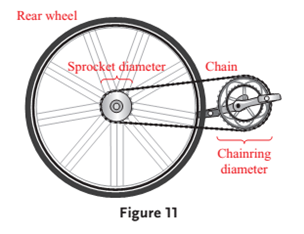
Concept explainers
Cycling When a cyclist pedals. he turns a gear, called a chainring. The angular velocity of the chainring will determine the linear speed at which the chain travels. The chain connects the chainring to a smaller gear, called a sprocket, winch is attached to the rear wheel (Figure 11). The angular velocity of the sprocket depends upon the linear speed of the chain. The sprocket and rear wheel rotate at the same rate, and the diameter of the rear wheel is 700 millimeters. The speed at which the cyclist travels is determined by the angular velocity of his rear wheel. Use this information to answer Problems 63 through 67.

A pro cyclist is climbing Mount Ventoux, equipped with a 150-millimeter-diameter chainring and a 95-millimeter-diameter sprocket. If he was pedaling at a rate of 90 revolutions per minute, find his speed in kilometers per hour.
Trending nowThis is a popular solution!

Chapter 3 Solutions
Trigonometry (MindTap Course List)
Additional Math Textbook Solutions
Pathways To Math Literacy (looseleaf)
APPLIED STAT.IN BUS.+ECONOMICS
Precalculus
Probability And Statistical Inference (10th Edition)
Finite Mathematics for Business, Economics, Life Sciences and Social Sciences
College Algebra (7th Edition)
- Please provide a clear and detailed solutionarrow_forwardPlot each point given its polar coordinates. Then, give another pair of polar coordinates for the same point with the opposite radius and angle 0 ≤ 0 < 2π (or 0 ≤ 0 < 360°). (-6, 120°)arrow_forwardFind two additional polar representations of the given point such that one has the same sign as r but the opposite sign of 0, and the other has the opposite sign of r but the same sign as 0. 3, - π 6arrow_forward
- e consider the problem -((1+x)))= 0 XE U(0) = 0, 'U(1)=\@Sind the analytical sol and he Find the Variational form and find Matrix A and b? consider the Variational form a (u,v)-(SV) where acu,v) = vdx prove that YVE H. (0,1),i=1, 2, \\-\ a(vi)=-v(x-1)+2V(xi)-(X;+1)] Where Vn is usual basis of hat functions. Consider the Problem Au=f and u= du=0 0 a with bilinear formalu,v) = SAU. AV r Prove that alu, v). V-ellPitic. and aluv) is continuous..arrow_forwardThe resistance, R, of a conductor is directly proportional to its length, 7. If the resistance. of 3.80 km of a certain transmission line is 121 ohms, find the resistance of 74.9 km of that line. Round your answer to 3 significant digits. Ωarrow_forwardThe number of widgets that a manufacturing plant can produce varies jointly as the number of workers and the time that they have worked. Find the constant of proportionality k to 2 decimal places if 455 workers work 6 hours and can produce 11493.3 widgets. k = How many widgets (to the nearest tenth) can be produced by 490 workers in 37 hours? Widgets =arrow_forward
 Algebra and Trigonometry (MindTap Course List)AlgebraISBN:9781305071742Author:James Stewart, Lothar Redlin, Saleem WatsonPublisher:Cengage Learning
Algebra and Trigonometry (MindTap Course List)AlgebraISBN:9781305071742Author:James Stewart, Lothar Redlin, Saleem WatsonPublisher:Cengage Learning Trigonometry (MindTap Course List)TrigonometryISBN:9781337278461Author:Ron LarsonPublisher:Cengage Learning
Trigonometry (MindTap Course List)TrigonometryISBN:9781337278461Author:Ron LarsonPublisher:Cengage Learning Holt Mcdougal Larson Pre-algebra: Student Edition...AlgebraISBN:9780547587776Author:HOLT MCDOUGALPublisher:HOLT MCDOUGAL
Holt Mcdougal Larson Pre-algebra: Student Edition...AlgebraISBN:9780547587776Author:HOLT MCDOUGALPublisher:HOLT MCDOUGAL Elementary Geometry For College Students, 7eGeometryISBN:9781337614085Author:Alexander, Daniel C.; Koeberlein, Geralyn M.Publisher:Cengage,
Elementary Geometry For College Students, 7eGeometryISBN:9781337614085Author:Alexander, Daniel C.; Koeberlein, Geralyn M.Publisher:Cengage, Elementary Geometry for College StudentsGeometryISBN:9781285195698Author:Daniel C. Alexander, Geralyn M. KoeberleinPublisher:Cengage Learning
Elementary Geometry for College StudentsGeometryISBN:9781285195698Author:Daniel C. Alexander, Geralyn M. KoeberleinPublisher:Cengage Learning Trigonometry (MindTap Course List)TrigonometryISBN:9781305652224Author:Charles P. McKeague, Mark D. TurnerPublisher:Cengage Learning
Trigonometry (MindTap Course List)TrigonometryISBN:9781305652224Author:Charles P. McKeague, Mark D. TurnerPublisher:Cengage Learning





